Roundup herbicide: a powerful remedy for all weeds on the site
Removing weeds is not a pleasant experience. The slightest inattention - and the harmful grass sprouts again. In the war against unwanted plants, all means are good, because only on clean soil will a healthy, abundant and tasty harvest grow. Application of Roundup chemical herbicide against weeds is a reliable way to quickly and effortlessly get rid of intruders on the site.
General information
| Country and company producing the drug | Avgust, Russia. |
| Price category | Price from 500 rubles per 1 liter. |
| Active ingredients | Glyphosate at a concentration of 360 g / l. |
| The substance gets on the aerial parts of the weed, penetrates the roots and slows down the synthesis of amino acids. | |
| Appointment | Against woody shrubs, grasses, annual and perennial weeds. Destroys willow, wheatgrass, nettles, marsh, burdock, cow parsnip, thistle, thistle, dandelion, clover, quinoa, spurge, bindweed, coltsfoot, etc. Oppresses all types of plants that fall. |
| Used on private households and on an industrial scale. | |
| Hazard Class | The third class of danger (moderately dangerous for humans and bees). |
| What plants is safe for | - |
| Resistance | There is a risk of resistance. |
| Speed of action | The first signs of wilting appear after 5-10 days. Death occurs in 21 days. |
| Protection period after processing | 2-3 months. |
| Waiting period | 7 days. |
| Additional effects | Not. |
| Combination with other means | Not compatible with other pesticides. After treating the garden with another substance, Roundup will not work - and vice versa. |
The active ingredient glyphosate is the world's most popular continuous-action herbicide. The manufacturer claims that when it gets into the soil, it does not harm cultivated plants. But the drug cannot be called rapidly decomposing: its residues can be in the soil for up to 1 year after treatment.
Glyphosate is controversial among experts: there are studies proving the toxicity of the pesticide to humans and animals.
Instructions for use
Roundup does not act on weeds through the soil. Only the spraying method will bring results - it is useless to water the area. For processing, you will need a spray bottle with small holes and a solution - it is prepared immediately before use.
The concentration of "Roundup" and the number of treatments per season depend on the characteristics of the area, as well as on the crops growing on it.
The recommended dosages for the destruction of different types of weeds, see below.
How to breed "Roundup" from weeds: instructions
| Plant | Solution concentration | Consumption | Number of treatments |
|---|---|---|---|
| Annual cereal and dicotyledonous weeds. | 80 ml for 10 liters of water. | 10 liters of ready-made solution for 200 m 2. | Single spraying in spring or summer. |
| Perennial cereal and dicotyledonous weeds. | 120 ml for 10 liters of water. | 10 liters of ready-made solution per 200 m 2. | Single spraying in spring or summer. |
| Plot for potatoes. | 40-60 ml per 10 liters of water. | 10 liters of ready-made solution for 200 m 2. | Single spraying 2–5 days before the emergence of potatoes. |
| For sowing vegetables and garden flowers. | 80-120 ml per 10 liters of water. | 10 liters of ready-made solution for 200 m 2. | Single spraying of vegetative weeds in autumn after harvest or single spraying in spring 14 days before sowing. The concentration depends on the type of weed - the more difficult it is to remove it from the site, the more concentrated the solution should be. |
| Processing of a plot for a lawn and other areas not intended for sowing cultivated plants. | 80-120 ml per 10 liters of water. | 10 liters of ready-made solution for 200 m 2. | Single spraying of vegetative weeds. |
The Roundup herbicide has a number of analogues that can be used to avoid resistance, that is, addiction of weeds to the poison. Examples: Typhoon, Agrokiller, Tornado.
How to properly breed and apply Roundup in the garden?
- It is forbidden to use food utensils.
- The concentrate is highly soluble in water and does not require long stirring. But for better dissolution, half of the water and the entire concentrate are first poured into the container. After stirring, add the remaining water.
- Container for solution preparation - plastic or metal coated against corrosion.
- The pesticide will kill weeds during the growing season. Spraying is carried out in spring, summer and autumn as needed.
- Spraying should be uniform. Only green mass is processed.
- Use only professional sprayers for spraying. A homemade spray bottle will not work.
If there are very few weeds in the garden, spray them pointwise with a small spray bottle, garden brush, or medical syringe.
Since Roundup is not a selective pesticide, beneficial crops must be protected with a waterproof material. Low-growing plantings are covered from above, in fruit trees, the lower part of the trunk is wrapped.
When a drop of herbicide hits the leaf, the plant will die and the grower will lose the crop. If this does happen, wash off the substance as soon as possible with a powerful jet of water.
Security measures
Be sure to read the instructions for use of the drug in order to avoid mistakes and not harm your health.
- Do not allow the herbicide to come into contact with the skin and mucous membranes. Put on chemical protection already at the time of preparation of the solution.
- Do not inhale vapors, use face shield, goggles and suit.
- It is forbidden to smoke, eat and drink during processing, otherwise pesticide vapors will get into the mucous membranes of the mouth with air.
After spraying the pesticide, do not visit the site without protective equipment for 5-6 hours. Keep children and animals away. Garden work can be resumed after a week.
Life-threatening dose of pesticide - 100 ml. If drops get on the body, nothing terrible will happen if you immediately wash them off with plenty of water and household soap. The eyes should be rinsed thoroughly with clean water, keeping them open. Ingestion of the herbicide is a more serious health threat. It is necessary to drink the sorbent and induce vomiting, and then immediately consult a doctor.
To avoid poisoning, immediately after gardening, wash your hands and face, and clean the protective elements. The spray bottle is thoroughly washed, the container from the concentrate is disposed of - burned away from residential areas.
Attention: it is forbidden to use and dispose of Roundup containers near water protection zones!
Common signs of herbicide poisoning:
- nausea;
- vomiting;
- labored breathing.
Storage rules for Roundup:
- In a dry place at a temperature of 15-30 ° С.
- Out of the reach of children and pets.
- Separated from food, animal feed, medicines.
- The finished solution is stored for up to 7-10 days in a container with a closed lid. After this time, the effectiveness of the pesticide is lost; it will have to be disposed of in a place determined by the environmental authorities for these purposes.
- The shelf life of a closed bottle is 5 years.
What could go wrong?
The following factors reduce the effectiveness of Roundup:
- A dusty layer on the leaves can prevent the penetration of the drug into the weed.
- Low temperatures can slow down the death of weeds.
- Fog, dew and rain interfere with the penetration of the substance into plant tissues and reduce its effectiveness. If precipitation is predicted, it is better to postpone the procedure. According to the instructions, the work is carried out on a dry day. However, overdried soil does not contribute to the rapid destruction of weeds. The more moisture in the soil, the more actively the grass stretches.The pesticide works best during the active green growth phase. What to do? The day before spraying, water the area or carry out treatment the next day after rain.
- The quality of the water for preparing the solution is important: particles of silt and clay partially neutralize the pesticide. For visible results use only purified water.
- Experienced gardeners recommend slightly increasing the concentrate dosage if the water is too hard.
- If you choose a pesticide, then skip weeding. The larger the aerial part, the better the poison works. It is best to alternate between hand weeding and spraying so that weeds do not develop addiction to glyphosate.
- A pesticide will not help against very small weeds up to 5 cm tall.
Weather conditions are also important because with a gust of wind, part of the sprayed herbicide reaches the crops. The permissible wind speed is 4–5 m / s. That is why autumn processing of the site is preferable when the harvest has already been collected.
Despite the fact that "Roundup" destroys all the excess greenery in the garden, it cannot influence the weed seeds in the soil. If after some time after spraying, especially tenacious weeds have again climbed, then the treatment is repeated.
In general, gardeners agree that the drug is expensive, but effective even in neglected areas. But only if all instructions are followed, Roundup is safe for humans.
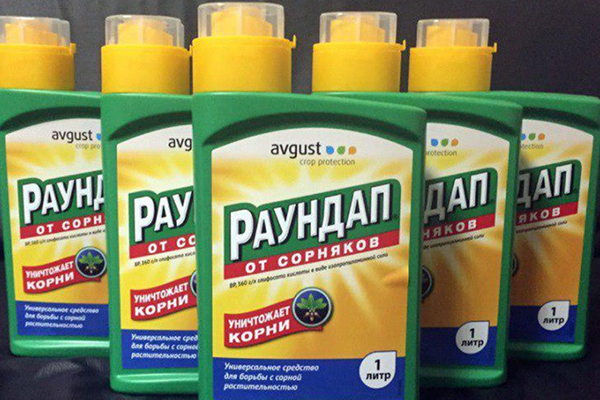
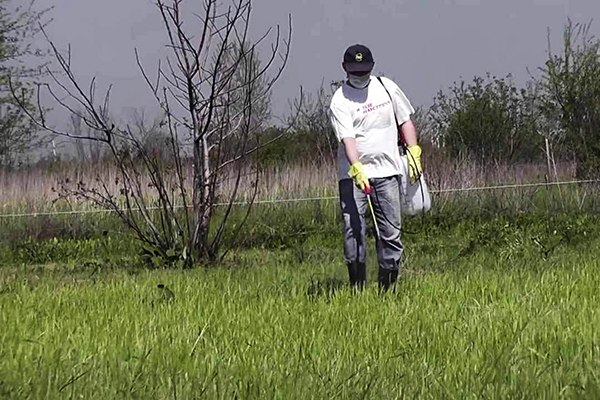
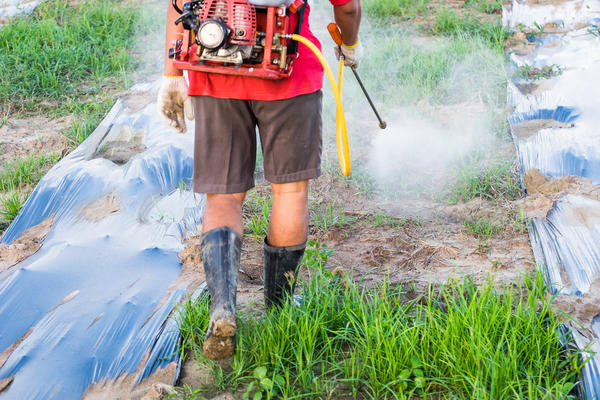
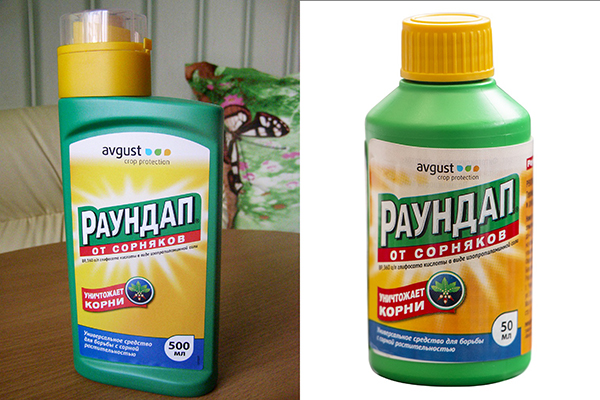
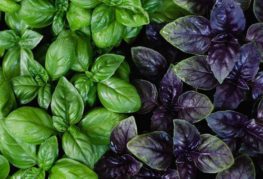

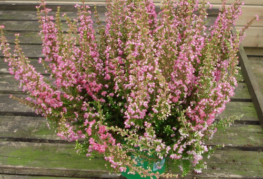

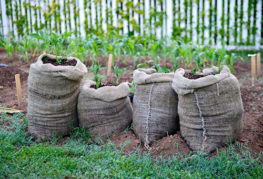
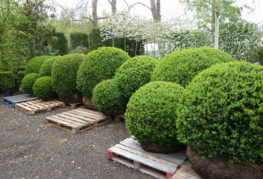
and will be published shortly.